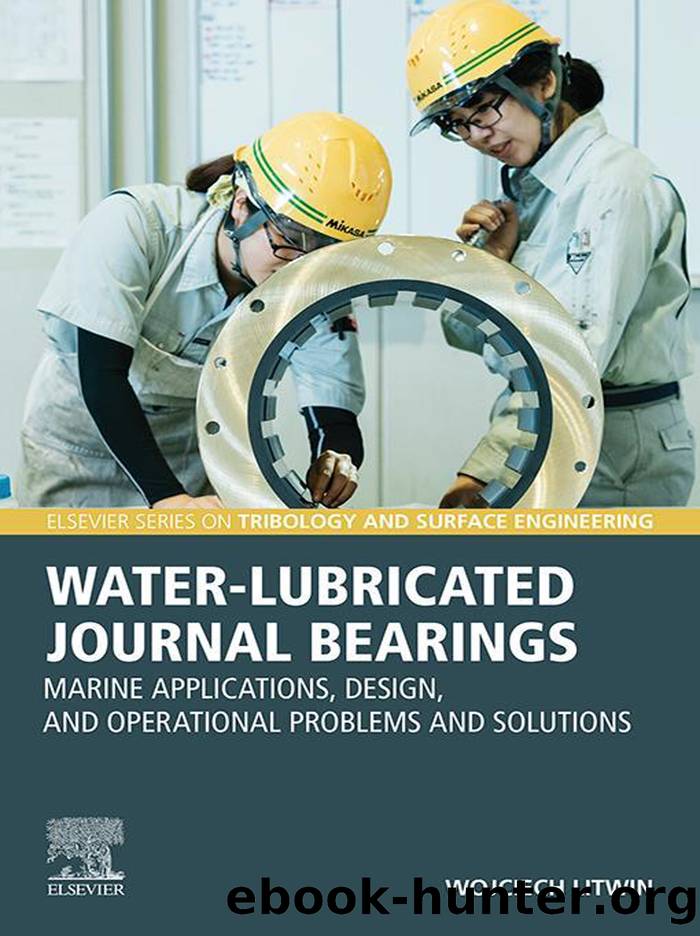Water-Lubricated Journal Bearings by Litwin Wojciech;

Author:Litwin, Wojciech; [Litwin, Wojciech]
Language: eng
Format: epub
Publisher: Elsevier
Published: 2024-12-15T00:00:00+00:00
The surface roughness of a co-working friction pair has a large influence on the resistance of motion, energy losses, and thermal processes taking place especially intensively in the run-in phase (Figs. 6.2.1 and 6.2.2).
Figure 6.2.1 Coefficient of friction of water-lubricated bearing with polymer bush, before (A) and after (B) running-in process.
Figure 6.2.2 Coefficient of friction of water-lubricated bearing with three-layer bush with PTFE sliding surface before (A) and after (B) running-in process.
The below-mentioned example consists of the experimentally acquired resistance of motion in the form of the friction coefficient as a function of a rotational speed of a 100 mm diameter shaft working in a polymer, elastic bush, in which lubrication grooves are machined only in the upper, non-loaded half of the bush, that is, in the way that is currently considered to be optimal. This bearing was characterized by good hydrodynamic properties, but a significant reduction of the resistance of motion could also be seen after a few hours of the running-in process. One should also note that, after smoothing the bushâs sliding surface, the start-up friction increased. This is connected with the stickslip processes occurring when, as a result of the acting adhesive forces, two sliding surfaces that remain at rest become attached to each other (Chapter 6.4).
In a bearing with inferior hydrodynamic properties due to having lubrication grooves present along the entire bush circumference, the running-in process will also be visible, although the coefficient of friction graph displays a different shape, typical for a bearing working in a mixed-friction zone (Fig. 6.2.2).
The significance of the surface condition on the hydrodynamic properties of sliding bearings was first noticed by researchers as early as the 1960s. Probably the first research works were carried out by Tzeng and Saibel in 1967 and concerned a flat sliding pair [14]. Based on the work conducted, the authors concluded that surface roughness may have a significant impact on the hydrodynamic capacity of a bearing; however, local changes (oscillations) should not be expected in the lubrication film. The results of calculations performed for roughness placed perpendicularly to the sliding direction were especially promising. These led to the conclusion that, in this specific case, one might expect a significant increase, as high as over 60%, in the hydrodynamic capacity of the bearing [15].
In the late 1970s, Patir and Cheng published a paper in which they analyzed a three- dimensional model of surface roughness [16â21], and the majority of their work concerns rolling friction, and therefore different contact conditions from those that appear in a radial bearing.
The authorâs own research on the impact of the surface condition on the bearingâs hydrodynamic properties was carried out on a test stand meant for conducting detailed tests of a single sliding bearing (Fig. 4.3). In selecting the bearing, an attempt was made to choose diverse materials with differing physical properties. That is why it was decided to use homogeneous materials such as polyamide, PET, and composite.
It was important, from the perspective of the ability to compare the experimental results with theoretical calculations, to test a bronze bush bearing.
Download
This site does not store any files on its server. We only index and link to content provided by other sites. Please contact the content providers to delete copyright contents if any and email us, we'll remove relevant links or contents immediately.
| Automotive | Engineering |
| Transportation |
Whiskies Galore by Ian Buxton(41524)
Introduction to Aircraft Design (Cambridge Aerospace Series) by John P. Fielding(32883)
Small Unmanned Fixed-wing Aircraft Design by Andrew J. Keane Andras Sobester James P. Scanlan & András Sóbester & James P. Scanlan(32569)
Craft Beer for the Homebrewer by Michael Agnew(17927)
Turbulence by E. J. Noyes(7690)
The Complete Stick Figure Physics Tutorials by Allen Sarah(7135)
Kaplan MCAT General Chemistry Review by Kaplan(6589)
The Thirst by Nesbo Jo(6432)
Bad Blood by John Carreyrou(6271)
Modelling of Convective Heat and Mass Transfer in Rotating Flows by Igor V. Shevchuk(6219)
Learning SQL by Alan Beaulieu(6029)
Weapons of Math Destruction by Cathy O'Neil(5822)
Man-made Catastrophes and Risk Information Concealment by Dmitry Chernov & Didier Sornette(5641)
Digital Minimalism by Cal Newport;(5388)
Life 3.0: Being Human in the Age of Artificial Intelligence by Tegmark Max(5182)
iGen by Jean M. Twenge(5155)
Secrets of Antigravity Propulsion: Tesla, UFOs, and Classified Aerospace Technology by Ph.D. Paul A. Laviolette(4974)
Design of Trajectory Optimization Approach for Space Maneuver Vehicle Skip Entry Problems by Runqi Chai & Al Savvaris & Antonios Tsourdos & Senchun Chai(4837)
Electronic Devices & Circuits by Jacob Millman & Christos C. Halkias(4739)
